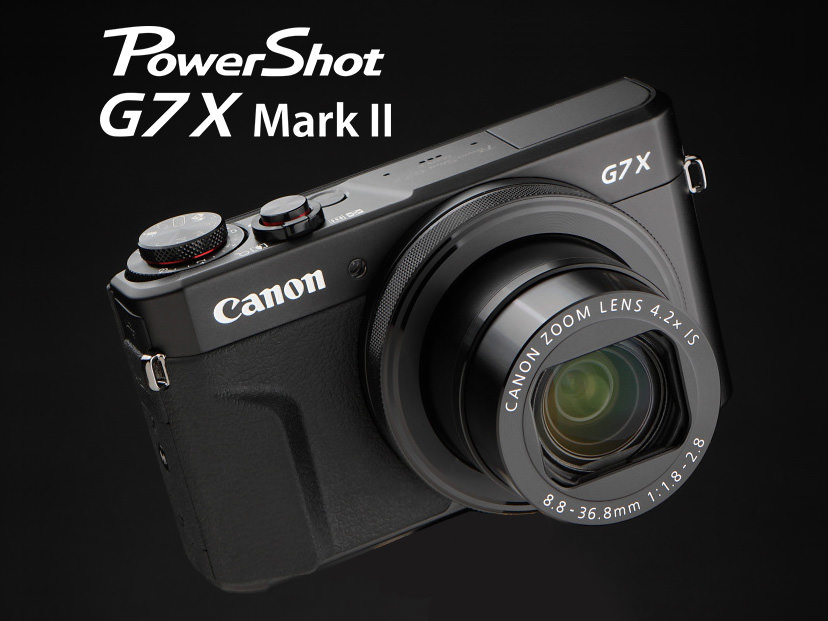The PowerShot G7 X Mark II is equipped with a 1.0-inch type back illuminated CMOS image sensor and the latest DIGIC 7 image processor. To top it all off, this compact digital camera also comes with the Picture Style function available on EOS cameras, letting you achieve consistent finishes for your shots. Read on to find out more about the camera’s flawless depiction capabilities in this photo review. (Reported by: Takeshi Ohura)

Check Point: Resolution and Periphery
I took distant shots at the wide-angle end 8.8mm (24mm equivalent), telephoto end 36.8mm (100mm equivalent), and mid-range (50mm equivalent) for comparison. For each of these angles of view, I used AF and kept the aperture at f/5.6. Across the board, I did not feel anything lacking at all regarding the visual appearance of the centre of the image. There were also no issues with the crispness of the edges. The image had a high degree of sharpness, with lines finely depicted.
At the 100mm equivalent and 50mm equivalent focal lengths, the depiction of the image periphery was superb. While there was a slight drop in the perceived resolution, I have to say that any bleeding or distortion of colour was virtually unnoticeable.
Vignetting in the periphery was well suppressed at maximum aperture, and the light reduction virtually disappears when the aperture is stopped down about 2 stops from there. Image finishing, in terms of reproductions of tone and gradations, are beyond reproach, especially when you take into consideration the fact that this is a compact camera all the way down to its optical design.
Wide-angle end (24mm equivalent)

f/1.8

f/2

f/2.8

f/4

f/5.6

f/8
Mid-range (50mm equivalent)

f/2.5

f/2.8

f/4

f/5.6

f/8
Telephoto end (100mm equivalent)

f/2.8

f/4

f/5.6

f/8
Check Point: ISO speed
The ISO speed of the PowerShot G7 X Mark II can be set anywhere from ISO 125 to ISO 12800. In the example, I took the shot with High ISO Speed Noise Reduction set to the default setting. As far as what can be seen in the photo shown below, there is very little noise or drop in perceived resolution up to ISO 800. There are also no issues such as colour bleeding.
At ISO 1600 and ISO 3200, some slight graininess occurs, and the crispness of the edges feels a little poorer when compared to ISO 800. However, there is no significant change in tone reproducibility, and unless the user is very particular about the image quality, there is nothing to be concerned about when using the camera for street photography.
At ISO 6400, luminance noise and chroma (colour) noise both begin to stand out. At the highest ISO speed of ISO 12800, a remarkable amount of noise occurs. At that speed, the perceived resolution drops, and the colour tone also feels a little strong in the finish. That said, for a compact digital camera, the noise is well-suppressed. When you look at the camera overall, it is not an exaggeration to say that it has superior high ISO speed performance.

ISO 125

ISO 800

ISO 6400

ISO 12800
Check Point: Macro mode
The closest focusing distance from the end of the lens is 5cm at the wide-angle end, and 40cm at the telephoto end. When doing close-up shooting, the camera quickly focuses on the subject where the selected focus point overlaps, in the same way as it would for normal shooting. The focus speed is comparatively quick, with minimal stress.
In relation to the depiction, weak flaring may occur, depending on the conditions, when using maximum aperture. While this can be resolved by stopping down the aperture, you might actually want to have a little fun with the faint depiction, as the effect is much similar to what you would get with vintage lenses. Meanwhile, the bokeh effect looks quite natural for a zoom lens, with less of an unnatural, noisy depiction.

PowerShot G7 X Mark II/ FL: 8.8mm/ f/5.6/ 1/1,000 sec/ ISO 125

PowerShot G7 X Mark II/ FL: 31mm/ f/2.8/ 1/1,250 sec/ ISO 125

PowerShot G7 X Mark II/ FL: 17.9mm/ f/2.5/ 1/400 sec/ ISO 125
Summing up: A camera representative of the G-series
With a 1.0-inch type CMOS sensor, which has close to three times the area for receiving light as the 1/1.7-inch type sensor previously synonymous with high image quality compact digital cameras, a 4.2x optical zoom lens with a maximum aperture of f/1.8 - 2.8, as well as the latest DIGIC 7 image processor, it is overwhelming when you think about what this compact digital camera is capable of. The high ISO speed performance is almost the same as that of an APS-C-size DSLR, and it doesn’t seem to be lacking at all in terms of areas such as tone reproduction, and image resolution. The PowerShot G7 X Mark II covers an extremely wide range of activities, from the documentation of trivial daily activities through to full-fledged product photography.
You might be thinking that the lack of an electronic viewfinder (EVF) is a drawback for a compact digital camera. However, for this camera it is the norm to use the LCD monitor when shooting, and because it is equipped with features such as a responsive and accurate AF, and powerful image stabilisation, it does not let me down even when I rely on the camera for a shoot. All of the current PowerShot G-series cameras are equipped with at least a 1.0-inch type sensor, so they are all capable of achieving a high quality finish. Even among those cameras, the PowerShot G7 X Mark II, in my mind, is the camera that possess the qualities befitting the standards of the G-series, judging from the height of perfection it has achieved.
Photo Gallery

PowerShot G7 X Mark II/ FL: 23.7mm/ f/5.6/ 1/800 sec/ EV +0.3/ ISO 125
The AF point can be selected via touch operation with the LCD monitor. The camera is also equipped with the touch shutter feature. When taking the photo above, I tapped on the containers in the foreground to focus the camera and trigger the shutter. I was only holding the camera in my left hand, but thanks to its powerful image stabilisation capabilities, I could obtain a sharp depiction of the scene.

PowerShot G7 X Mark II/ FL: 12.8mm/ f/8/ 1/160 sec/ EV ±0/ ISO 125
The actual focal length was 12.8mm, and the f-number was f/8. The edges might be slightly too sharp, yet they do not feel so unnatural. I was a little concerned that viewers might notice a drop in the perceived resolution in the bottom left of the image.

PowerShot G7 X Mark II/ FL: 36.8mm/ f/2.8/ 1/500 sec/ EV±0/ ISO 125
Image taken at the telephoto end, at maximum aperture. The angle of view is 100mm equivalent, with the size of the bokeh as you see it here. When compared with cameras equipped with a 1/1.7-inch type sensor, it goes without saying that the bokeh is larger.

PowerShot G7 X Mark II/ FL: 36.8mm/ f/4/ 1/400 sec/ EV ±0/ ISO 125
When shooting at the telephoto end, as in the shot above, I still long for the EVF, to be honest.

PowerShot G7 X Mark II/ FL: 36.8mm/ f/2.8/ 1/250 sec/ EV+1/ ISO 125
Even with a bright background, the subject (in this case, a bicycle) has good contrast. The edges are crisp too. The AF is also accurate when shooting at the telephoto end with maximum aperture. I was a little concerned that the background blur appeared slightly chaotic.

PowerShot G7 X Mark II/ FL: 10.2mm/ f/5.6/ 1/250 sec/ EV+0.3/ ISO 125
I matched the exposure with the white boat. However, the highlights and shadows persist in the image. Because I shot in direct light, the sunlight hit the LCD monitor directly, yet this did not greatly reduce the visibility.

PowerShot G7 X Mark II/ FL: 8.8mm/ f/5.6/ 1/1,000 sec/ EV -0.3/ ISO 125
Another new feature of this camera is Picture Style. EOS-series users will be able to enjoy a finish with a familiar feature, and furthermore, be able to adjust colours that are less than perfect just as they would on EOS-series cameras. You can even adjust the Picture Style parameters.

PowerShot G7 X Mark II
For the behind-the-scenes story behind the development of the PowerShot G7 X Mark II, check out Interview with Developers: PowerShot G7 X Mark II (Part 1).

Born in 1965 in Miyazaki Prefecture, Ohura graduated from the Department of Photography, College of Art, Nihon University. After his career with the editorial department of a motorcycle magazine and a design planning firm, he became a freelance photographer. He writes mainly for photography magazines based on his experience in using digital cameras for commercial shoots. Outside of work, he enjoys looking at photos and makes it a point to visit galleries regularly. Ohura is a member of the Camera Grand Prix Selection Committee.

Delivers daily news related to topics such as digital cameras and peripheral devices, and imaging software. Also publishes articles such as reviews on the use of actual digital camera models and photo samples taken using new models.

































